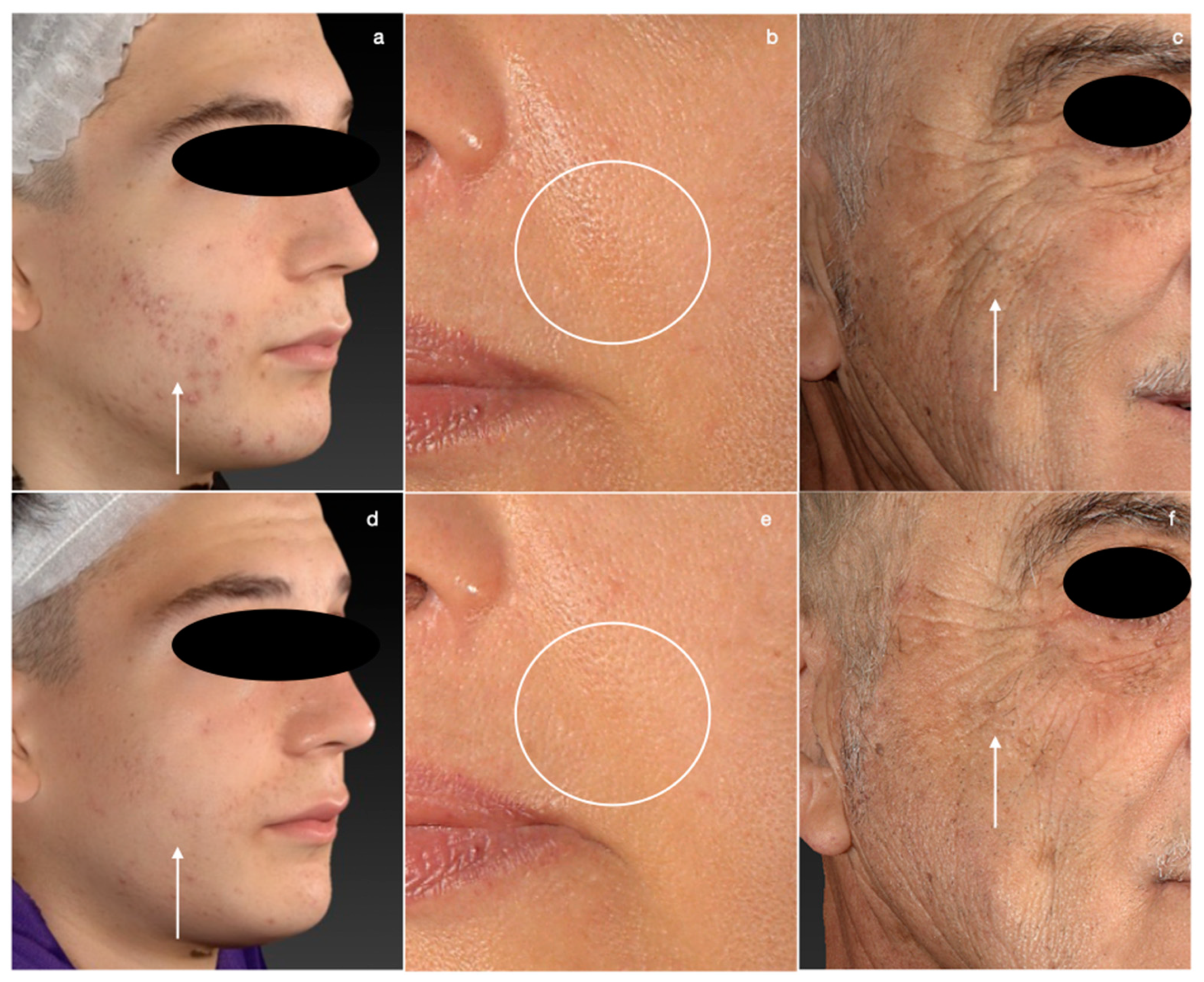Carbon Peeling Laser Treatment to Improve Skin Texture, Pores and Acne Lesions: A Retrospective Study
Abstract
:Author Contributions
Funding
Institutional Review Board Statement
Informed Consent Statement
Data Availability Statement
Conflicts of Interest
References
- Guida, S.; Fulgione, E.; D’Ambra, I.; Babino, G.; Pellacani, G.; Farnetani, F. Carbon Peel Laser Technique to Improve Skin Quality: Back to Science! Dermatol. Pract. Concept. 2020, 10, e2020113. [Google Scholar] [CrossRef] [PubMed]
- Shoshani, D.; Markovitz, E.; Monstrey, S.J.; Narins, D.J. The modified Fitzpatrick Wrinkle Scale: A clinical validated measurement tool for nasolabial wrinkle severity assessment. Dermatol. Surg. 2008, 34 (Suppl. 1), S85–S91. [Google Scholar] [CrossRef] [PubMed]
- DiBernardo, G.A.; DiBernardo, B.E. Prediction of Treatment Outcomes for Neck Rejuvenation Utilizing a Unique Classification System of Treatment Approach Using a 1440-nm Side-Firing Laser. Aesthet. Surg. J. 2018, 38 (Suppl. 2), S43–S51. [Google Scholar] [CrossRef] [PubMed]
- Ning, Y.; Qing, Z.; Qing, W.; Li, L. Evaluating photographic scales of facial pores and diagnostic agreement of tests using latent class models. J. Cosmet. Laser Ther. 2017, 19, 64–67. [Google Scholar] [CrossRef] [PubMed]
- Alsulaimani, H.; Kokandi, A.; Khawandanh, S.; Hamad, R. Severity of Acne Vulgaris: Comparison of Two Assessment Methods. Clin. Cosmet. Investig. Dermatol. 2020, 13, 711–716. [Google Scholar] [CrossRef] [PubMed]

| Baseline Characteristics | Patients N = 32 n (%) | ||
|---|---|---|---|
| Sex: | |||
| Females | 13 (40) | ||
| Males | 19 (60) | ||
| Phototype: | |||
| 1 | 3 (9) | ||
| 2 | 6 (19) | ||
| 3 | 15 (47) | ||
| 4 | 8 (25) | ||
| Scores | Before treatment n (%) | After treatment n (%) | p§ |
| FWAS *: | 0.012 | ||
| 1 | 4 (12) | 6 (18) | |
| 2 | 16 (50) | 16 (50) | |
| 3 | 10 (32) | 10 (32) | |
| 4 | 2 (6) | 0 | |
| Pores: | <0.01 | ||
| No obvious pores | 0 | 6 (18) | |
| Minimal pores | 4 (12) | 22 (70) | |
| Mild pores | 18 (57) | 4 (12) | |
| Moderate pores | 10 (31) | 0 | |
| IGA #: | <0.01 | ||
| Few comedons and <1 small inflammatory lesion | 0 | 14 (44) | |
| Dozens of comedons and several inflammatory lesions | 26 (81) | 16 (50) | |
| Many comedons, several inflammatory lesions and <1 nodule | 6 (19) | 2 (6) | |
| GAIS °: | |||
| exceptional improvement | 2 (6) | ||
| very improved | 14 (44) | ||
| improved | 16 (50) | ||
| unaltered | 0 | ||
| worsened | 0 |
Publisher’s Note: MDPI stays neutral with regard to jurisdictional claims in published maps and institutional affiliations. |
© 2022 by the authors. Licensee MDPI, Basel, Switzerland. This article is an open access article distributed under the terms and conditions of the Creative Commons Attribution (CC BY) license (https://creativecommons.org/licenses/by/4.0/).
Share and Cite
Conforti, C.; Guida, S.; Dianzani, C.; Turco, P.; Cazzato, V.; Zalaudek, I.; Piccolo, D. Carbon Peeling Laser Treatment to Improve Skin Texture, Pores and Acne Lesions: A Retrospective Study. Medicina 2022, 58, 1668. https://doi.org/10.3390/medicina58111668
Conforti C, Guida S, Dianzani C, Turco P, Cazzato V, Zalaudek I, Piccolo D. Carbon Peeling Laser Treatment to Improve Skin Texture, Pores and Acne Lesions: A Retrospective Study. Medicina. 2022; 58(11):1668. https://doi.org/10.3390/medicina58111668
Chicago/Turabian StyleConforti, Claudio, Stefania Guida, Caterina Dianzani, Piergiorgio Turco, Vito Cazzato, Iris Zalaudek, and Domenico Piccolo. 2022. "Carbon Peeling Laser Treatment to Improve Skin Texture, Pores and Acne Lesions: A Retrospective Study" Medicina 58, no. 11: 1668. https://doi.org/10.3390/medicina58111668
APA StyleConforti, C., Guida, S., Dianzani, C., Turco, P., Cazzato, V., Zalaudek, I., & Piccolo, D. (2022). Carbon Peeling Laser Treatment to Improve Skin Texture, Pores and Acne Lesions: A Retrospective Study. Medicina, 58(11), 1668. https://doi.org/10.3390/medicina58111668








